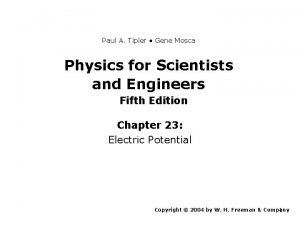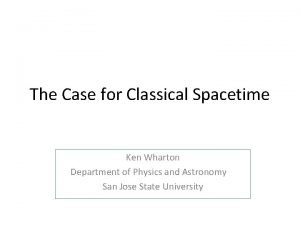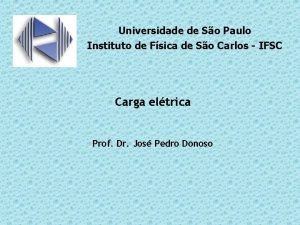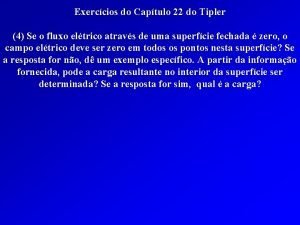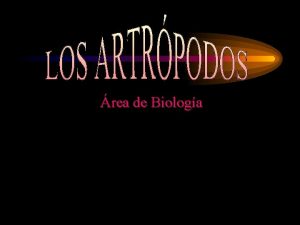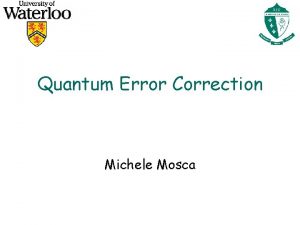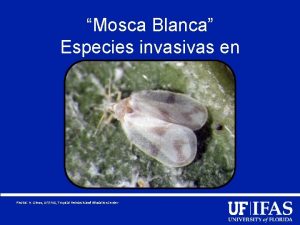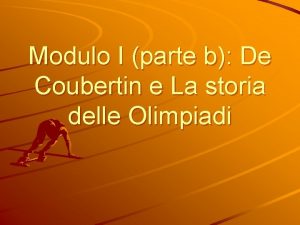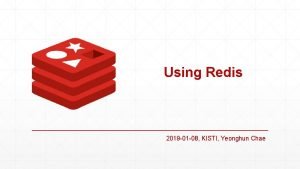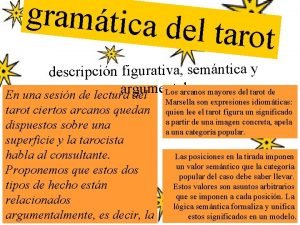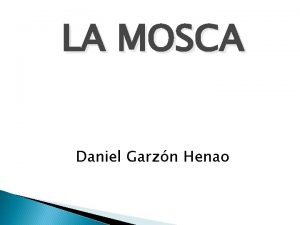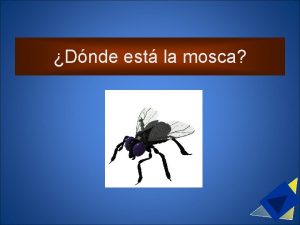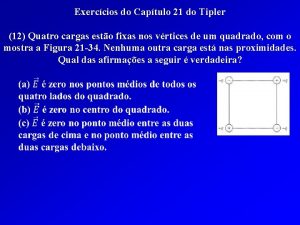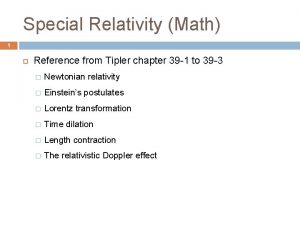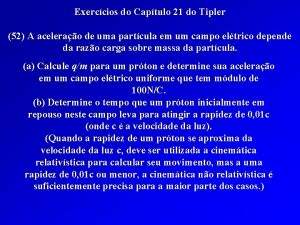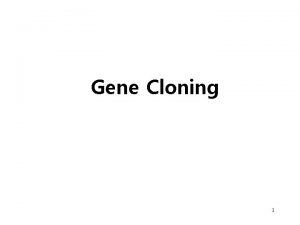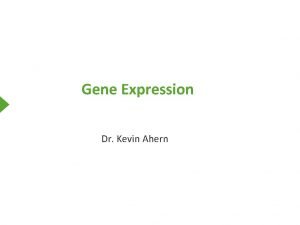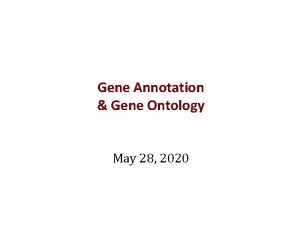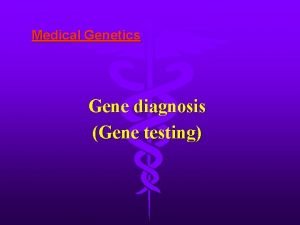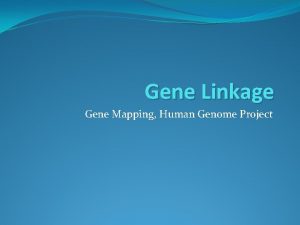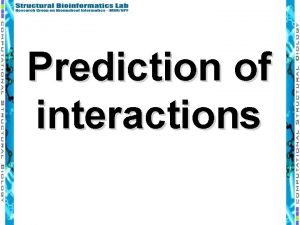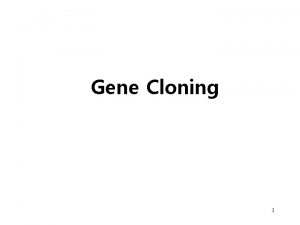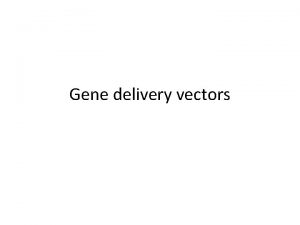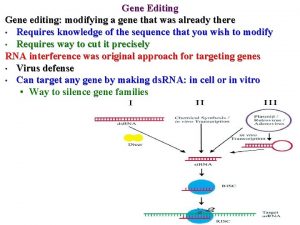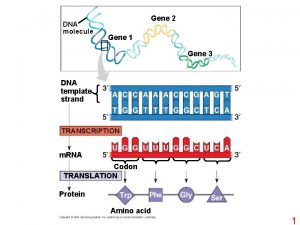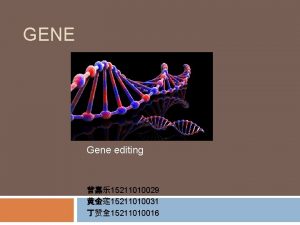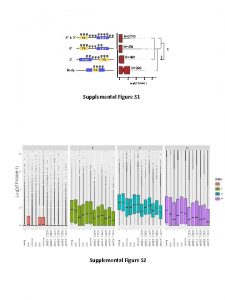Paul A Tipler Gene Mosca Physics for Scientists



































































- Slides: 67

Paul A. Tipler • Gene Mosca Physics for Scientists and Engineers Fifth Edition Chapter 22: The Electric Field II: Continuous Charge Distributions Copyright © 2004 by W. H. Freeman & Company 1

2

3

4

5

Effect of Symmetry 6

7

8

9

10

11

12

13

14

15

16

17

18

19

22 -2 Gauss’s Law 20

Gauss’s Law • Electric Flux • Charge Distribution • Relationship between field lines and charge 21

Electric Flux • • E varies with density of lines Flux is #lines crossing a specific area Flux and “Flow” Symbol f Units: N·m 2/C Product of Field and Area Can be + or 22

Electric Flux (cont. ) • Flux + when leaving a closed surface • Flux - when entering a closed surface 23

Electric Flux (cont. ) • Notice that there is no charge inside • and, Net Flux is zero 24

Case where E is spatially uniform: • f = E·A (E factored out of integral) • f = +EA (E parallel to A) • f = -EA (E anti-parallel to A) 25

Flux through both surfaces is identical 26

Flux and Charge • Amount and sign of a charge can be determined by (#lines leaving) – (#lines entering) 27

(#lines leaving) – (#lines entering) = 0 net charge enclosed is zero 28

net 8 lines leaving = net +q enclosed (with 8 lines per q) 29

Flux due to a point Q 30

• Net Flux not dependent on shape of enclosing surface or any charges outside the enclosure • Net Flux does depend on amount of charge inside enclosure 31

32

Cylindrical can enclosing part of an “infinite” plane of Q. 33

Plane of Charge cont. Net flux = EA + 0 = 2 EA == 4 pkq E = 4 pkq/2 A = 2 pk(q/A) = 2 pks. 34

Gauss’s Law in terms of Permittivity Gauss’s Law Permittivity of a vacuum, Gauss’s Law 35

Spherical Shell • • cosine = 1 (symmetry) f = EA = Q/eo E = Q/eo. A A = 4 pr 2. 36

Spherical Shell cont. any closed surface inside shell has Qenc = 0 è EA ~ Q = 0 èE=0 37

“Field”: Concept or Reality? 38

Long Line 39

Uniform Spherical Volume non-zero values inside same as pt Q outside 40

22 -4 Discontinuity of En 41

42

22 -5 Charge and Field at Conductor Surfaces 43

E on Conductor • at surface E = s/eo • E normal (perpendicular) to surface • E is zero inside (with static charges) 44

+Point Q inside Shell • shell = neutral conductor • -/+ induced on shell • E ~ same as for lone +pt Q. 45

Charge Distribution Field Shape 46

Summary • E obtained by sum of effect of all charges • charges can be point (ch 21) or ‘continuous’ (ch 22) • E can also be obtained by use of Gauss’s Law for E, where concept of E flux is used. 47

22 -6 Derivation of Gauss’s Law From Coulomb’s Law 48

49

50

Problems 51

52

53

54

55

56

57

58

59

60

61

62

63

64

65

66

67
 Dr gene tipler
Dr gene tipler Tipler
Tipler Tipler
Tipler Cilindros de tipler
Cilindros de tipler Gene by gene test results
Gene by gene test results Chapter 17 gene expression from gene to protein
Chapter 17 gene expression from gene to protein Aparato bucal
Aparato bucal Mosca theorem
Mosca theorem Emilia mosca
Emilia mosca Cemer - centro medico de enfermedades respiratorias
Cemer - centro medico de enfermedades respiratorias Huevos de mariposa sobre una hoja de frambuesa
Huevos de mariposa sobre una hoja de frambuesa Olimpiadi mosca 1980
Olimpiadi mosca 1980 Mosca npm
Mosca npm Vamos arando dijo la mosca
Vamos arando dijo la mosca Modern physics vs classical physics
Modern physics vs classical physics University physics with modern physics fifteenth edition
University physics with modern physics fifteenth edition Ib physics ia samples
Ib physics ia samples Formuö
Formuö Novell typiska drag
Novell typiska drag Tack för att ni lyssnade bild
Tack för att ni lyssnade bild Ekologiskt fotavtryck
Ekologiskt fotavtryck Varför kallas perioden 1918-1939 för mellankrigstiden
Varför kallas perioden 1918-1939 för mellankrigstiden En lathund för arbete med kontinuitetshantering
En lathund för arbete med kontinuitetshantering Särskild löneskatt för pensionskostnader
Särskild löneskatt för pensionskostnader Tidbok för yrkesförare
Tidbok för yrkesförare Anatomi organ reproduksi
Anatomi organ reproduksi Förklara densitet för barn
Förklara densitet för barn Datorkunskap för nybörjare
Datorkunskap för nybörjare Tack för att ni lyssnade bild
Tack för att ni lyssnade bild Debatt artikel mall
Debatt artikel mall Autokratiskt ledarskap
Autokratiskt ledarskap Nyckelkompetenser för livslångt lärande
Nyckelkompetenser för livslångt lärande Påbyggnader för flakfordon
Påbyggnader för flakfordon Kraft per area
Kraft per area Svenskt ramverk för digital samverkan
Svenskt ramverk för digital samverkan Jag har gått inunder stjärnor text
Jag har gått inunder stjärnor text Presentera för publik crossboss
Presentera för publik crossboss Argument för teckenspråk som minoritetsspråk
Argument för teckenspråk som minoritetsspråk Vem räknas som jude
Vem räknas som jude Treserva lathund
Treserva lathund Luftstrupen för medicinare
Luftstrupen för medicinare Bästa kameran för astrofoto
Bästa kameran för astrofoto Cks
Cks Lågenergihus nyproduktion
Lågenergihus nyproduktion Mat för idrottare
Mat för idrottare Verktyg för automatisering av utbetalningar
Verktyg för automatisering av utbetalningar Rutin för avvikelsehantering
Rutin för avvikelsehantering Smärtskolan kunskap för livet
Smärtskolan kunskap för livet Ministerstyre för och nackdelar
Ministerstyre för och nackdelar Tack för att ni har lyssnat
Tack för att ni har lyssnat Hur ser ett referat ut
Hur ser ett referat ut Redogör för vad psykologi är
Redogör för vad psykologi är Borstål, egenskaper
Borstål, egenskaper Tack för att ni har lyssnat
Tack för att ni har lyssnat Borra hål för knoppar
Borra hål för knoppar Vilken grundregel finns det för tronföljden i sverige?
Vilken grundregel finns det för tronföljden i sverige? Standardavvikelse
Standardavvikelse Tack för att ni har lyssnat
Tack för att ni har lyssnat Rita perspektiv
Rita perspektiv Informationskartläggning
Informationskartläggning Tobinskatten för och nackdelar
Tobinskatten för och nackdelar Toppslätskivling dos
Toppslätskivling dos Datumr
Datumr Egg för emanuel
Egg för emanuel Elektronik för barn
Elektronik för barn Fredsgudinna
Fredsgudinna Strategi för svensk viltförvaltning
Strategi för svensk viltförvaltning Var 1721 för stormaktssverige
Var 1721 för stormaktssverige
